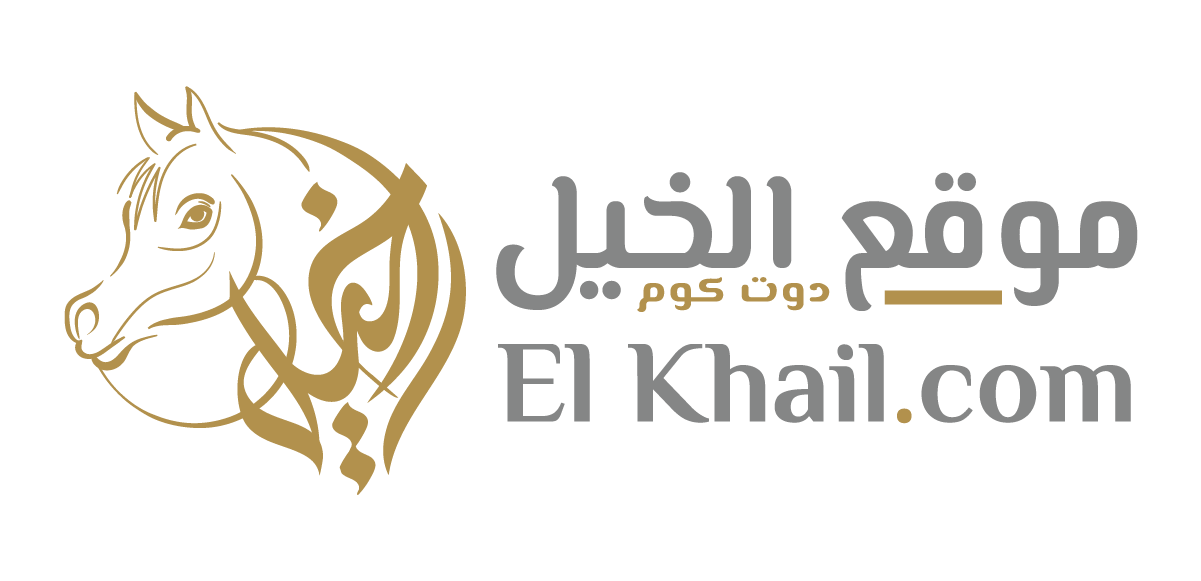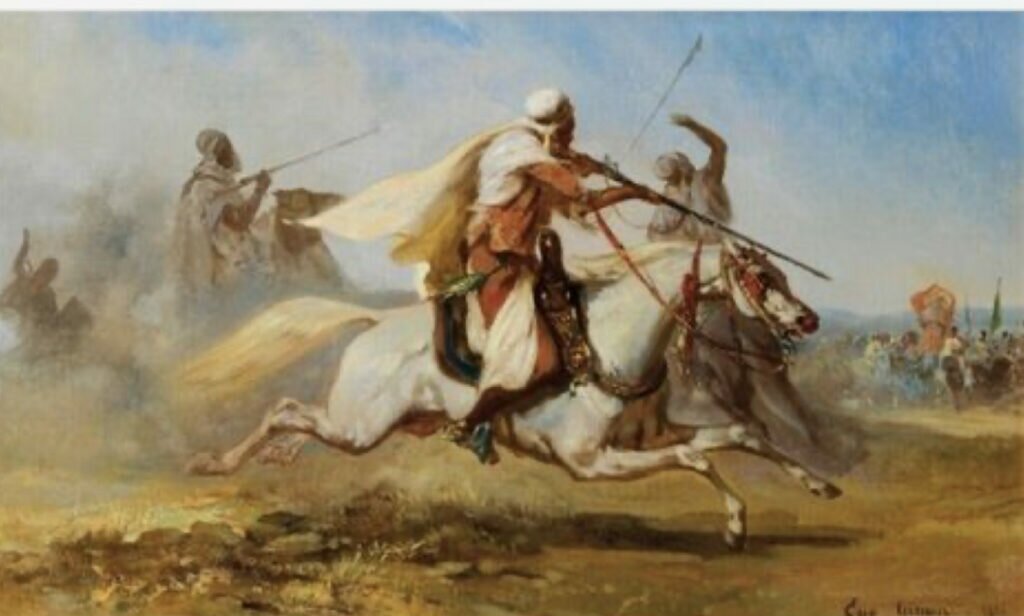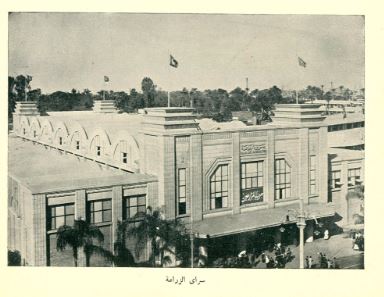There are certain signs and specifications, through which we can judge a good horse, just as there are signs of an old, patient, ferocious mare, and the previous mare, and others.
The most important signs of a “good mare” are the thinness of the bosom, large nostrils, long ears, prominent eyes, less fleshy cheeks, prominent tonsils, and short elbows.
The Manuscript of Al- Bajirmi explains in the statement of the signs of a good horse that it should be sweeping knees, sparse nerves, broad trotting, black groves, legions and hooves, thin spurs, long tail and neck, short back, and rounded hindquarters.

Marks of the archaic patient fiend
As for Al-Atiq, the Patient Al-Dharee’, called Al-Kahil, it is marked by the intensity of his breath, the wideness of his stomach and nostrils, the length of his neck, the bone of his thighs, the tightness of his loins, and the churning of his lobes.
The manuscript makes it clear that when the horse’s breath is strong, and his breathing is narrow, he does not benefit himself greatly; Because if he runs for a long time, and he needs patience, his breath will wander in his stomach, and he does not go out, so he is reprimanded and distressed, stops running and gets tired.
And if he is very breathless and wide, and he is not wide in his stomach, he does not want the breath in his stomach, and he is not patient with the distance and the long end.
As for the length of his neck, he uses it to run, relying on the thigh bone.
The manuscript attributes the importance of the strength of his hooves to his need to meet with them pillars, solid ground, and rocks.
The manuscript highlights that one of the clearest signs and the clearest evidence in the knowledge of the “patient, ancient Persian” is that his shakira, which is the origin of his knowledge, the hair of his forelock and what appeared from the upper part of his body, was smooth and soft like carded silk when touched. or from the mother.
The manuscript advises that, in the case of the obscurity of the matter of the patient antique, that we put water for him in a flat bowl on flat ground for him to drink from; If he drinks without blessing his knee and does not groan when he is groaning, then he is an old horse, patient and devout. Because he does not drink unless his feet are erect while he is standing on them, and one of his signs is that he puts all his nose in water at the time of drinking, and that his eyes are kohl on the tip of his ear.
previous signs
Among the signs of the “former” is that his neck is long, high and not low, that his legs meet together at the time he runs without separation, that his breath is fierce, his eyes are iron, his limbs are far apart, his eyelids are thin, his nostrils are wide, his teens are bare, his neck and loins and his forefathers are thin. His hocks are proportional, his legs are short, and his heels are small.
The manuscript explains that the first horse is between its legs at the time of its running in excess of six cubits, equivalent to twelve feet in some of them.
The best, noblest and finest horses, old and patient; Because the Messenger – may God’s prayers and peace be upon him – preferred it over other horses and Arabized it, i.e. he called it Arabic, and made two shares for it from the booty, and made one share for the hybrid mare.
One of the characteristics of the patient old man is that the jinn do not pretend in the house they are in, and linking them to the house expels the jinn from it.
These descriptions have four origins, namely: the wideness of the nose, the wideness of the hollow, the hardness of the hooves, and the intensity of the breath. Then there are four others: the length of the neck, the bone of the thighs, the tightness of their veins, and the tightness of the peritoneum of the abdomen, and with the exception of these eight, if any, then good, and if not, there is no problem.
Horse running mattresses from the Bajirmi manuscript
He came in the manuscript of Al-Bajirmi in the context of his talk about the running of the horse as saying: And they mentioned that the horse in its running ranks: Dhari’ is patient, and Dhari’ only, and patient only, and he lost them.
The first: “Al-Drai’ Al-Sabir” is full of character, good in character, strong in spirit, broad in breathing. The more he increased in the length of his legs, neck, arms, and thigh bone, the more he increased in his arms. The first thing in him is patience, and if he is patiently patient, he will be more perfect and more generous.
The second: “Al-Dhari’ only,” meaning the one who has no patience, and he has a long neck, arms, and legs, and great thighs.
The third: “the patient only”, that is, without a means, and he is the one whose neck is not excessive in length, and his hands are not wide, and his legs are not long, and whose thighs did not grow large, and whose flesh did not increase, and he gathered when he came, and his legs are not spread, and he is very breathless, wide in the hollow and breathing. That horse flies, and does not reach the size of a swarm, so if its legs, arms, neck, and thigh bone are arms, if it increases something in this circumstance, its arm increases, and I have the possession of things with horses is patience, and the best of it is if patience is combined with arm.
Fourth: He lost them, and he is disfigured, ugly in character, breathless, short of breath, and widespread in women.
The manuscript points out that there is not one of these qualities in a horse but that you let him down from patience, so if his character is strong and his women are short, and his character has improved, his breathing must be welcomed and his nostrils wide, if his breathing is wide and his nostril is narrow, the trick is to slit his nose, if his stomach and breathing are narrow, there is no trick. In him, even if he is of complete character, and is not very outgoing, the trick is for him to ejaculate once or twice in order to make himself hard, and the evidence of the severity of his breath is his magnanimity if you agitate him, so you see him like a panicked because of his intensity, his loneliness, the intensity of his gaze and the extent of his limbs.
Descriptions of approval in the Persians as mentioned by Al-Bajirmi
Al-Bajirmi mentioned the descriptions of approval in the Persians, where he said: The descriptions of approval in the Persians include: to be a community of character, proportionate in members, small in head moderately, long neck, thick core – meaning the middle of the chest – thin cheeks, lips, shoulders and throat, long ears, long tongue and smooth cheeks The hair of the forehead is moderate, the justice is narrow – the position of the excuse is above the forelock – the forehead, the chest and the nostrils are wide.
The descriptions of admiration in the mare also include that the eyes are kohl, prominent cheeks, sharp-sighted, rectangle slit, round lips, and the upper lip is closer to the length, and the teeth are stacked red at the uvula, which is the farthest of the mouth, large pulp, the middle of the chest, full Qasrah, which is the origin of the neck, long to the hinge, which is above the withers, short and flat in the back, large in the sides and in the hollow, folded in the sweep, flowing in the ribs, level of the flanks, wide in the hollow.
It also includes the fact that the mare has a dome in the abdomen, the mushrib of the cat – which is the seat of the rider – is rounded with a short and flat back, short buttocks, the origin of the tail, full in moderation, black in the urethra, broad in times, thick and rounded thighs, thick legs, straight knees and a pleasant function. It is above the wrist to the knee, and the wrist is articulated between the palm and the forearm, the wrists are short and thick, the wrists are stiff, the ankles are round, the heels are rounded, the hocks are limited, the hoofs are black and green, the spike is attached to the ground, it is the tip of the hoof, the eagle is high, its flesh, it is dry in the hoofs, and it is soft. Poetry; Because its softness in animals and birds’ prey, Mahmoud indicates strength.
And the advantages in the Persians add to the softness of the thankful one, and it is the hair that is above the forelock and around the knowledge, and if you touch it with your hand, you will find it softer than silk, and if it is coarse, it indicates crossbreeding, and to be a pure-hearted, energetic when riding and moving and drooling if he walks, looking at the ground with his eyes with his head raised.
If these descriptions meet in a mare, the physiognomy is not disappointed in the test.
Standard details in the merits of the Persians in the Bajirmi manuscript
Al-Bajirmi mentioned in his manuscript standard details of the virtues of the Persians, he said: There is no doubt that what combines these descriptions (beauties of the horse) is that the horse should be close in things, far in things, long in things, short in things, naked in things, huge In things, gentle in things, thick in things, gentle in things, narrow in things, immersed in things, broad in things, new in things.
The farthest in the horse is achieved in twelve places: to be far between its ears, between the hips and forelocks, between the upper arms and the knees, between the armpits and the elbows, between the two sides and the two veils, between the two veils, between the two veils and the two sockets, between the hock and the two veils, and between the epitaxes and the upper part. The two veils.
The horse is close in ten things: between the nostrils, between the two beards, between the two shoulders and the two veils, between the side, the hindquarters and the buttocks, between the two stomachs and the two cuticles, between the two cuticles and the buttocks, between the two cuticles and the armpits, between the two shortenings and the two eyelids, between the shoulder blades, and between the two thighs. And the heels.
As for the mare being long, that is achieved in eight things: the blade of the head, the neck, the ears, the arms, the shoulders, the gaze, the hips, and the legs.
The mare is short in nine things: the upper arms, the palms of the hands, the back, the legs, the wrists, the juju, the joints, the buttocks, and the frames.
And he is naked in twelve things: he is naked in the flankers, the forehead, the stalk of the nose, the throat, the soles of the legs, the crow, the top of the two veils, the ross of the two veils, the hark, the poisons, the bellies of the ears, and the belly of the hoof.
It is huge in nine things: the buttocks , the thighs, the knees, the pigeons, the hooves, the groins , the risers, the two cheeks, and the shoulders.
A mare should be gentle in seven things: the hare, the width of the nostrils , the eyelids, the eyebrows, the ears, the skin, and the hair.
The mare is also kind to five things: the straying, the falcon, the place of the elbows, the eagles, and the legions.
And it is narrow in seven things: a violation of hearing, a tightness between the beards, the armpits, the buttocks, the pomegranate, the elbows, and the compound of vultures.
The mare is also inserted into the two thighs, which are the compound thighs at the top of the legs.
The mare is wide in thirteen things: the cheeks, the forehead, the shortness, the bark, the flankers, the horseshoe, the side, the peritoneum, the buttocks, the hips, the thighs, the buttocks, and the shoulders.
It is also spacious in eight things: the cheeks, the nostrils, the groin, the inner thigh, the hollow, the tongue, and the lean, and it is the highest between the thighs.
The horse is iron in nine things: the eyes, the ears, the shoulders, the elbows, the heart, the two hocks, the two stars, the shaft, and the two veils.






